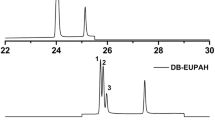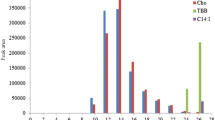Summary
A group of non-planar PCBs (IUPAC nos. 28, 52, 101, 118, 138, 153, and 180) was identified in a cod-liver oil product by using high resolution gas chromatography-mass spectrometry (HRGC/MS) in electron impact (EI) and negative chemical ionization (NCI) modes. The cod-liver oil samples were prepared either in a cyano column by high performance liquid chromatography (HPLC) or by a solid phase extraction (SPE) clean-up procedure that included e.g. purified charcoal treatment. The two methods of sample preparation were evaluated on the basis of the detectabilities of the congeners. The GC/MS-SIM method allowed quantitative monitoring of congeners nos. 52, 101, 118, 138, 153, and 180 at low concentration levels. Detection limits were 1.2 pg and 130 fg (m/z 292.00) in EI and NCI modes, respectively. The determination levels in EI and NCI were 1.8 pg and 290 fg in HPLC followed by HRGC/MS and 170 pg and 27 pg in SPE followed by HRGC/MS. The linear range was from 5.0 pg/μl to 1.0 ng/μl and from 1.0 pg/μl to 1.0 ng/μl in EI and NCI modes, respectively. In addition, the co-planar PCBs, PCDDs, and PCDFs were also screened and two of the chlorinated furanes were identified by HRGC/MS-NCI after separation from non-planar PCBs by SPE. In this case the only congeners that could be quantified were 2,3,4,7,8-PCDF and 1,2,3,4,6,7,8-HCDF, the detection limit for them being 740 fg (m/z 351.90) with NCI. SPE allows the separation of the planar and non-planar compounds, but LC separation is more effective for separation of the compounds of interest from the matrix. LC clean-up is easier and faster to perform than SPE clean-up.
Similar content being viewed by others
References
G. Lindström, C. Rappe, Chemosphere20, 851 (1990).
H. Hyvönen, S. Rovio, H. Sirén, M.-L. Riekkola, The Symposium Proceedings of the 14th International Symposium on Capillary Chromatography, edited by P. Sandra and M.L. Lee, Baltimore, USA, May 25–29, 1992, 639.
G. Lindström, C. Rappe, Chemosphere17, 921 (1988).
J.D. McKinney, L. Moore, A. Prokopetz, D.B. Walters, J. Assoc. Off. Anal. Chem.67, 122 (1984).
J. Tarradellas, H. Muntau, H. Beck, Commun. Eur. Communities EUR 10361, pp. 124–156, Brussels, 1986.
H. Hyvönen, T. Auvinen, M.-L. Riekkola, K. Himberg, J. Microcolumn Separations4, 123 (1992).
Author information
Authors and Affiliations
Additional information
Dedicated to Professor Leslie S. Ettre on the occasion of his 70th birthday.
Rights and permissions
About this article
Cite this article
Sirén, H., Hyvönen, H., Saarinen, M. et al. Comparison of HPLC and solid phase clean-up methods for identification of PCBs in cod-liver oil by HRGC/MS-SIM technique. Chromatographia 34, 421–430 (1992). https://doi.org/10.1007/BF02268378
Received:
Revised:
Accepted:
Issue Date:
DOI: https://doi.org/10.1007/BF02268378




